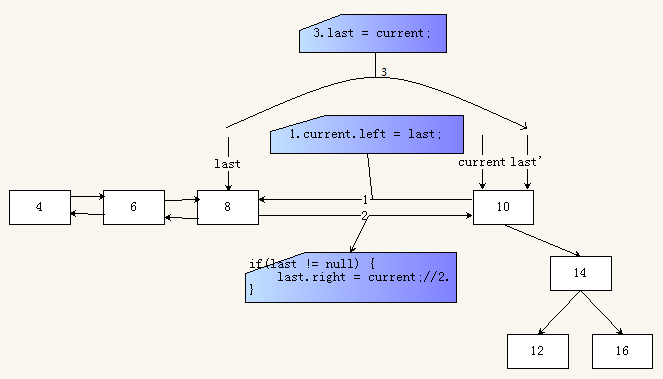题目
输入一棵二叉搜索树,将该二叉搜索树转换成一个排序的双向链表。要求不能创建任何新的节点,只能调整树中节点指针的指向。比如,输入下图中的二叉搜索树,输出转换之后的排序双向链表。

二叉树节点的定义如下:
public static class TreeNode {public int val;public TreeNode left;public TreeNode right;public TreeNode(int x) { val = x; }
}
分析
众所周知,中序遍历二叉搜索树会得到有序的序列,我们目标是在中序遍历二叉搜索树过程中,逐步将其转换成有序的双向链表。另外,将树节点的左子树指针转换成双向链表节点的前驱指针,而树节点的右子树指针转换成双向链表节点的后驱指针。

放码
import com.lun.util.BinaryTree.TreeNode;public class ConvertBSTToLinkedList {private TreeNode last;//用于指向双向链表的尾节点public TreeNode convert(TreeNode root) {convertNode(root);TreeNode head = last;while(head != null && head.left != null) {head = head.left;}return head;}private void convertNode(TreeNode node) {if(node == null) {return;}TreeNode current = node;if(current.left != null) {convertNode(current.left);}current.left = last;//1.执行到这步,左子树已经转换成有序双向链表if(last != null) {last.right = current;//2.}last = current;//3.current转换成有序双向链表的新尾节点if(current.right != null) {convertNode(current.right);}}}
测试
import org.junit.Assert;
import org.junit.Test;import com.lun.util.BinaryTree;
import com.lun.util.BinaryTree.TreeNode;public class ConvertBSTToLinkedListTest {@Testpublic void test() {ConvertBSTToLinkedList cbl = new ConvertBSTToLinkedList();TreeNode root = makeABST();TreeNode head = cbl.convert(root);Assert.assertEquals("4 -> 6 -> 8 -> 10 -> 12 -> 14 -> 16 -> \n" + "16 -> 14 -> 12 -> 10 -> 8 -> 6 -> 4 -> ", printList(head));}private TreeNode makeABST() {int[] array = {10, 6, 14, 4, 8, 12, 16};return BinaryTree.integerArray2BinarySearchTree(array);}private String printList(TreeNode head) {String result = "";TreeNode p = head;while(true) {result += (p.val + " -> ");if(p.right == null) {break;}p = p.right;}result += "\n";while(p != null) {result = result + p.val + " -> ";p = p.left;}return result;}}







大全)

SQL语句的基本书写规则)


)





